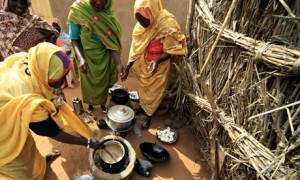Cookstove designs are failing the poorest communities | Source/complete article: Guardian Sustainable Business Blog, Feb 7, 2014.
Excerpts – Cookstoves are desperately needed in refugee camps but current designs aren’t working. Bottom-up innovation is vital.
With all the knowledge and technology we have at our disposal, why is it proving so difficult to design and create simple and efficient cookstoves for the three billion people who use them in the developing world?
This is the question posed by T. Alexander Aleinikoff, the United Nations deputy high commissioner for refugees, who complains that stoves are being designed with little thought for the people who use them.
The Office of the United Nations High Commissioner for Refugees (UNHCR) gets sent a steady stream of newly designed cookstoves from entrepreneurs around the world, but none of them has so far come up to scratch.
Every year around four million people die from smoke inhalation. Inefficient stoves, which rely on solid fuels, also contribute to climate change and deforestation.
“We’re in the situation where everybody and his brother has invented a cookstove and none of them have really worked well for us,’ says Aleinikoff.
“I’ve been in refugee camps where large, beautiful solar cookstoves were used as storage places because they didn’t cook the food fast enough.”

Cookstove designs are not working because the design process has not been bottom up, starting with the needs of those who use them. Photograph: Mohamed Nureldin Abdallah/REUTERS
Aleinikoff says designers mistakenly think they can come up with a one-size-fits-all approach, failing to understand the cultural complexity of cooking or the conditions in which the stoves are used.
“The stoves that we get are from people who sat in laboratories and said ‘gee this kind of gas is very efficient’. But what does it cook? What is the food refugees want to cook? When do they cook it? How does it fit into their social and cultural patterns?”
He says the UNHCR needs to become more innovative in its approach, as the current organisational culture does not encourage flexibility among field staff to adapt to different circumstances.
Aleinikoff says: “When I was in Dollo Ado [Ethiopia] this last week, I was standing in one part of the camp and there were these mesh structures and I said ‘what are these?’, and was told ‘these are the kitchens we’ve built outside the homes but no-one’s using them; they didn’t work’. ‘Who designed them?’ I asked. ‘We designed them back in headquarters’ was the response.”
Aleinikoff points to some areas around refugee camps that have been virtually stripped of trees, and says this also causes conflicts with the established local community.
Per Heggenes, the CEO of the Ikea Foundation, which has formed a strategic partnership with the UNHCR, believes this is exactly the type of area in which philanthropy can make a practical difference.
- Source/complete article: Guardian Sustainable Business Blog, Feb 7, 2014.



